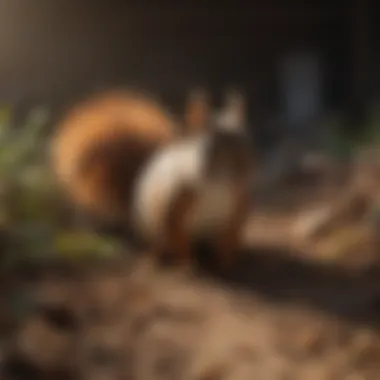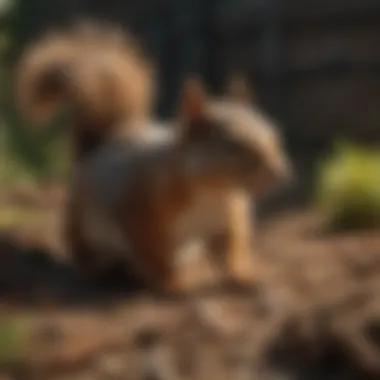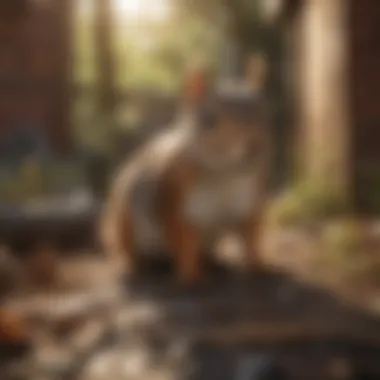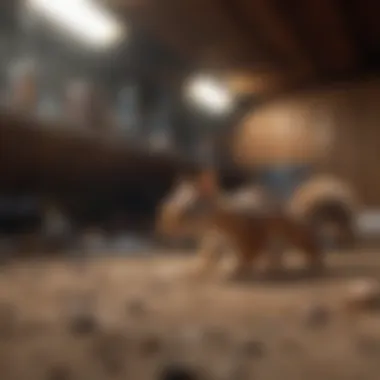Effective Strategies for Squirrel Removal in Crawl Spaces


Intro
Squirrel infestations can be a challenging issue for homeowners and property managers. These creatures often find their way into crawl spaces, leading to potential damage and health risks. Understanding how to prevent such scenarios from arising is paramount. By employing effective preventive pest control strategies, one can keep these rodents at bay. This article will delve into various methods designed to create a pest-resistant environment, further exploring effective removal techniques when infestations do occur.
Preventive Pest Control Strategies
To safeguard your property from squirrels and other pests, it is crucial to implement preventive measures. These strategies address various aspects of home maintenance, from protecting the exterior of the house to ensuring indoor cleanliness. By focusing on these areas, homeowners can reduce the chance of infestations significantly.
House Exterior Protection
The first line of defense against squirrels is a well-maintained house exterior. Sealing all possible entry points is essential.
- Tips for sealing cracks: Inspect the exterior regularly for cracks or holes. Use caulk or expandable foam to seal small gaps, particularly around windows, doors, and foundations.
- Clearing debris: Maintain a clear space around your home's foundation. Remove any branches, piles of leaves, or other debris that could serve as nesting materials.
- Preventing pests from entering: Install wire mesh over vents and chimneys to block access, and consider using heavy-duty steel screens where necessary.
Yard Maintenance
Regular yard care routines are vital in keeping pests at bay.
- Essential yard care routines: Regularly mow the lawn, prune overgrown shrubs, and clear away any fallen fruits or nuts that may attract squirrels.
- Methods for keeping yard pest-free: Consider using landscaping rocks instead of wood chips, as the latter can harbor pests. Additionally, keeping bird feeders at a distance from structures can also deter squirrels.
Indoor Cleanliness
An often overlooked aspect of pest prevention is maintaining a clean indoors.
- Expert cleaning tips and techniques: Regularly vacuum and dust, especially in hard-to-reach areas. Ensure that food is stored in sealed containers and that spills are cleaned immediately.
- Maintaining a pest-resistant indoor environment: Ensure that your indoor plants do not contribute to pest habits. Keep plants healthy and inspect them regularly for signs of infestations.
Garbage Disposal
Proper garbage disposal is another crucial element in preventing squirrel infestations.
- Efficient waste disposal methods: Utilize garbage cans with secure lids. This will help keep food scraps that attract pests out of reach.
- Importance of proper garbage disposal: Ensure that composting is done correctly. Compost should not contain food scraps that might attract squirrels or other rodents.
Other Pest Prevention Strategies
Beyond traditional methods, there are innovative ways to further safeguard your property.
- Consider using motion-sensor lights around your yard. This can deter nocturnal pests.
- Adopt a holistic pest management approach, integrating various methods to maintain a pest-free environment.
"Preventive pest control strategies are the foundation of effective pest management. A proactive approach can often save significant time and resources in the long run."
By implementing these suggested strategies, homeowners can significantly reduce the risk of squirrel infestations. The next sections will detail how to identify pest risk areas and the effective pest control methods that can be employed.
Understanding the Squirrel Problem
Understanding the problem posed by squirrels is crucial for effectively managing infestations, particularly in crawl spaces. Squirrels, while often seen as harmless creatures, can create serious issues for homeowners. Their behavior and habits make them adept at nesting in areas that are typically ignored. This insight informs the necessary steps for prevention and removal.
Behavior of Squirrels
Squirrels are highly adaptable animals. They are known for their ability to thrive in urban environments. Typically, they are active during the day and prefer areas with abundant food sources like nuts, seeds, and fruits. Their foraging behaviors can lead them into gardens, attics, or crawl spaces in search of shelter and food. Squirrels are also territorial and will defend their nests aggressively if threatened.
Their agility allows them to scale trees and buildings with ease. This physical ability, combined with their inquisitive nature, often leads them to exploit even the smallest entry points into homes. Understanding this behavior helps homeowners recognize potential vulnerabilities before an infestation occurs.
Common Reasons for Infestation
There are several reasons squirrels may invade crawl spaces. Commonly, these include:
- Access Points: Openings in roofs, vents, or, notably, crawl space entrances provide easy access.
- Food Availability: If your environment has accessible food sources, squirrels are likely to be drawn in.
- Shelter Requirements: Crawl spaces offer warmth and protection from predators, enticing squirrels to nest there.
Recognizing these pull factors can assist homeowners in taking proactive measures to dissuade squirrels from entering.


Risks Associated with Squirrels in Crawl Spaces
The risks related to squirrels nesting in crawl spaces are significant. They may damage insulation, chew through wiring, and even impact the structural integrity of a home. Additionally, squirrels can carry parasites and diseases, potentially posing health risks to humans and pets. Their droppings can lead to unsanitary conditions and facilitate the growth of harmful bacteria.
"A single squirrel family can cause thousands of dollars in damage if their presence is ignored."
All these risks underline why understanding the squirrel problem is the first step in maintaining a safe and healthy home environment. By being aware of their behaviors, the triggers for infestations, and the associated risks, homeowners can implement effective prevention and removal strategies.
Identifying the Signs of Infestation
Recognizing the signs of squirrel infestation is crucial for effective management. Early identification can prevent further damage and assist in implementing removal strategies sooner rather than later. Squirrels can cause significant harm to property, particularly in crawl spaces where they can nest and breed. Identifying these signs will enable homeowners to take necessary actions to maintain their living environment. This section outlines key indicators of squirrel presence, focusing on visual clues, noise indicators, and damage assessment.
Visual Clues
Visual clues are often the first indication of a squirrel problem. Homeowners might notice droppings, which are small, dark, and resemble mouse droppings but are larger in size. These can be found in corners and near entry points in the crawl space. Additionally, gnawed wood or insulation is a strong sign. Squirrels have strong teeth and can chew through materials to create nests or access food.
Some other visual signs include:
- Footprints or tracks in dust or dirt
- Nesting materials like leaves, twigs, or shredded insulation around entry points
- Search for signs of nesting in rafters or corners, often indicated by accumulated debris
Identifying these visual indicators early is essential to effectively address the issue before it escalates.
Noise Indicators
Noises can also serve as a warning that squirrels have invaded a crawl space. Homeowners often report hearing scratching, scurrying, or gnawing sounds, particularly during early morning or evening hours when squirrels are most active. These sounds can resonate through the walls or floorboards and become quite noticeable.
Some common sounds to listen for include:
- Scratching noises as squirrels move against surfaces
- Thumping or bumping sounds when they are organizing nesting materials
- High-pitched chirps or chatter that can occur during social interactions
If you hear consistent noises coming from the crawl space, it may indicate that squirrels have made it their home.
Damage Assessment
Finally, assessing any damage is vital in determining the severity of an infestation. Squirrels can cause structural damage by chewing on wood, electrical wires, and insulation. Homeowners should inspect the crawl space for any signs of wear or damage that can be attributed to squirrel activity.
Potential damages may include:
- Gnaw marks on wooden beams or joists
- Torn insulation from nesting efforts
- Chewed wiring, which poses a fire hazard
- Water damage as they may create pathways that allow for moisture entry
Conducting a thorough inspection of the crawl space is essential. In summary, recognizing these signs quickly can help to prevent extensive damage and allow for prompt corrective action.
Remember: Timely identification of squirrel infestation signs can lead to more effective and humane removal efforts.
Preventive Measures
Preventive measures are vital when addressing squirrel infestations in crawl spaces. By proactively managing your property, you reduce the likelihood of these pests taking up residence in your home. Implementing effective preventive strategies not only aids in keeping squirrels at bay but also protects your property from potential damage. Understanding this importance is crucial for homeowners who seek to maintain their living spaces and avoid costly repairs.
Sealing Entry Points
The first step in prevention involves identifying and sealing entry points. Squirrels can enter your crawl space through surprisingly small openings, often as little as two inches in diameter.
Begin by inspecting vents, plumbing access points, and any cracks in the foundation or walls. Use strong materials such as metal mesh or hardware cloth to cover these areas. These materials are durable and resistant to gnawing.
Important: Regularly check these seals, as wear and tear from weather can weaken the barriers over time.
Limiting Food Sources
Squirrels are resourceful creatures that seek food sources near their nesting areas. Limiting available food plays a significant role in keeping them away. Start by ensuring that trash bins are secured with tight-fitting lids to prevent scavenging.


Also, avoid leaving pet food outside. If you have bird feeders, choose squirrel-proof designs and place them away from structures to further deter them. Squirrels have a strong sense of smell, so consider cleaning any areas where food may have spilled to remove attractants.
Landscape Management
The management of your landscape contributes heavily to squirrel prevention. Trim tree branches that come too close to your roof or crawl space. Squirrels are excellent climbers, and trees that connect to your home can act as bridges. Keep bushes and shrubs well-trimmed as well, reducing their hiding spots.
Additionally, consider replacing or removing tall grasses and dense vegetation near the foundation, as these can serve as nesting sites. In summary, a well-maintained landscape can greatly reduce the likelihood of a squirrel infestation.
Humane Removal Techniques
Humane removal techniques are essential for addressing squirrel infestations in crawl spaces. These methods emphasize ethics and compassion while resolving a pest problem. Understanding humane removal not only aligns with wildlife protection laws but also minimizes harm to the animals and the ecosystem.
The benefits of humane approaches are manifold. They foster a sense of responsibility toward wildlife. Additionally, humane removal can be effective in preventing future infestations. Many homeowners prefer strategies that do not involve lethal means, reflecting a broader trend in responsible pest management.
Live Trapping
Live trapping is one of the most effective humane removal techniques. It involves the use of specially designed traps that capture squirrels without causing them harm. The traps are usually baited with appealing food, such as nuts or seeds, to attract the squirrels.
When implementing live trapping, it is crucial to place traps in locations where squirrel activity is evident. This might be near entry points or areas where droppings have been found. Frequent checking of the traps is necessary. Leaving a trapped squirrel unattended for an extended period can cause stress and discomfort.
Once a squirrel is trapped, it's essential to handle the situation quickly and responsibly.
Relocation Guidelines
Relocation of trapped squirrels should be conducted in a careful and compliant manner. First, check local regulations regarding wildlife relocation. Some jurisdictions have specific rules about where and how far you can relocate animals. Generally, squirrels should be moved at least several miles away from the capture site to reduce the chances of returning.
When choosing a relocation site, consider an area that provides natural habitat, such as wooded or overgrown regions, where squirrels can thrive. After transporting the squirrel, ensure it has adequate food and shelter in its new environment.
Be prepared for the possibility that relocating squirrels can have ecological impacts. Introducing squirrels to a new area can disrupt local ecosystems if not done carefully.
Professional Assistance
While many homeowners can successfully employ humane removal techniques, some situations warrant professional assistance. Wildlife control experts possess the training and tools necessary for effective humane removal. Hiring professionals can provide peace of mind, especially for those inexperienced with live trapping or relocation.
Professional services ensure compliance with local laws and offer solutions tailored to specific environments. They can also conduct thorough assessments of properties to identify potential entry points and recommend preventive measures.
Post-Removal Considerations
Once the immediate challenge of squirrel removal has been addressed, it becomes necessary to focus on the next steps to ensure that your crawl space remains free of these persistent pests in the future. This phase is critical, involving a thorough assessment of any damage caused, implementation of preventive measures, and establishing a system for ongoing monitoring. These steps not only secure your property but also help maintain your home’s structural integrity and overall value.
Assessing Damage and Repairs
After the squirrels have been successfully removed, it is essential to evaluate the extent of the damage they may have caused during their intrusion. Inspect the crawl space for any signs of compromised insulation, chewed wiring, or structural damage to beams and supports.
- Insulation Damage: Often, squirrels damage insulation materials as they enter or make nests. Replacing damaged insulation is necessary for energy efficiency and home comfort.
- Wiring Inspection: Chewed electrical wires can pose a serious fire hazard. Hire a qualified electrician to inspect any affected wiring, especially if you notice exposed wires.
- Structural Repairs: Check for any weakened structural components. A structural engineer may be needed if significant damage is found.
Repairing these issues promptly can mitigate further complications, potentially saving money in the long run.
Preventing Reentry
To avoid facing a similar issue with squirrels again, it is imperative to implement effective preventive measures. Sealing any potential entry points is crucial. Squirrels can squeeze through surprisingly small gaps, so attention to detail is required.
- Identify Entry Points: Common areas include loose vents, gaps in siding, and cracks in the foundation. Ensure all potential access points are thoroughly sealed using durable materials like steel mesh or caulk.
- Install Screens: For ventilation openings, consider adding fine mesh screens to restrict entry without sacrificing airflow.
- Maintain Landscaping: Trim trees and bushes near the home to limit access routes for squirrels. Keeping branches at least six feet away from roofs and siding can reduce their likelihood of reaching vulnerable areas.
Ongoing Monitoring
Continual vigilance is key to maintain a squirrel-free environment after removal. Establish a monitoring routine to catch signs of any new infestations early.
- Scheduled Inspections: Conduct regular inspections of the crawl space at least once every few months. Look for any signs of new animals, such as droppings or nesting materials.
- Keep Records: Document any signs of infestation as well as actions taken. This record can provide valuable insights into patterns and help you adapt your monitoring approach over time.
- Seek Professional Assistance: If signs of reentry persist, do not hesitate to contact local wildlife control experts. Their specialized knowledge may reveal underlying issues that might not be apparent to an untrained eye.


"Preventing reentry and ongoing monitoring are the best ways to ensure the efforts made in removing squirrels were not in vain."
Adopting these post-removal strategies lays a solid foundation for protecting your home from future infestations. By being proactive, you can enjoy peace of mind, knowing that your home is safe and secure.
Legal and Ethical Considerations
When dealing with squirrel infestations, it is crucial to navigate the legal and ethical considerations surrounding their removal. Understanding these elements not only ensures compliance with local laws but also fosters respect for wildlife. Improper handling can result in legal repercussions and negatively impact local ecosystems.
Local Wildlife Regulations
Local wildlife regulations vary significantly depending on the region. Many jurisdictions protect certain species of squirrels due to their ecological roles. For example, the Eastern Gray Squirrel is often classified under local wildlife laws that restrict removal methods and timing. It is essential for homeowners to research and be aware of housing and local wildlife regulations before attempting any removal strategy.
Failure to comply could result in fines or other legal actions. Resources like local wildlife departments or government websites often provide the necessary information. Homeowners can consult these regulations to understand:
- Permissible methods of removal: Some regions may only allow humane traps, while others have stricter protocols.
- Timing restrictions: There may be specific seasons when trapping or relocation is prohibited to protect nesting families or young squirrels.
- Reporting requirements: In some areas, it may be necessary to report captures to wildlife authorities.
Ethical Trapping Practices
Ethical trapping practices are paramount when removing squirrels from crawl spaces. These methods consider the well-being of the animal while also providing an effective solution for homeowners. Using humane traps that minimize stress and harm to squirrels is a critical aspect of ethical trapping.
Important guidelines for ethical trapping include:
- Choose the right type of trap: Live traps should be used to capture squirrels without causing injury. Avoid lethal traps unless absolutely necessary and legally permitted.
- Check traps regularly: To ensure captured squirrels do not suffer unnecessarily, traps should be checked frequently, ideally every few hours.
- Use proper bait: Attracting squirrels can often be done using appealing foods like nuts or sunflower seeds, ensuring they enter without fear.
- Relocation guidelines: Once traps are set, identify suitable areas for relocation far enough from your home. Local wildlife laws often dictate how far you must transport the animal to ensure it does not return.
Ensuring ethical practices not only aids in humane treatment but also strengthens community relations, fostering a responsible approach to wildlife management.
By adhering to both local regulations and ethical trapping practices, homeowners can enjoy a responsible and effective resolution to their squirrel infestation. Respecting wildlife encourages harmony between nature and residential areas, creating a healthier environment for all.
Resources and Support
Addressing a squirrel infestation may seem daunting, but adequate resources and support can significantly ease the process. Understanding the avenues available for help, be it from professionals or community programs, enhances the chances of successful squirrel removal and prevention. By tapping into these resources, property owners can effectively navigate the challenges associated with rodent control while ensuring humane practices.
Local Wildlife Control Services
Employing local wildlife control services is one of the most effective strategies to handle squirrel infestations. These organizations often have specialized training in humane removal techniques and understand local wildlife regulations. The benefits of hiring such services include:
- Expertise: Professionals have in-depth knowledge about squirrel behavior and patterns. They can quickly assess the situation and determine the best removal strategy.
- Safety: Trained personnel are equipped to handle wildlife safely, minimizing risks to both them and the residents. Proper tools and techniques are used in removal efforts, reducing the likelihood of injury or damage.
- Follow-up Services: Many wildlife control services offer additional help after the initial removal. This includes assessing damages, repairing entry points, and implementing long-term prevention strategies.
"Expert assistance not only ensures effective removal but also aids in fostering an understanding of local wildlife dynamics."
A proactive approach involves researching licensed and reputable wildlife control services in your area. Websites such as reddit.com can be valuable for obtaining local reviews and recommendations. Furthermore, maintaining lines of communication with pest control professionals is crucial for ongoing support and advice.
Community Assistance Programs
Apart from professional services, community assistance programs can also play an essential role in squirrel management. These initiatives often focus on educating homeowners about humane practices and preventive measures. Here are some potential benefits of connecting with community programs:
- Education & Resources: These programs can provide useful information about best practices for squirrel control. Workshops or seminars may be offered, teaching residents about safe and effective strategies for managing pests.
- Networking Opportunities: Being part of a community program allows homeowners to connect with neighbors facing similar challenges. Sharing experiences and solutions can lead to collaborative efforts in pest management.
- Lower Costs: Some community initiatives may offer free or low-cost services, making it accessible for a larger audience. They can help individuals who might not otherwise afford professional intervention.
Engaging with local forums, neighborhood groups on platforms like facebook.com, or community centers can lead to discovering available assistance programs. This engagement can unite efforts against squirrel infestations, creating a knowledgeable community that prioritizes humane and effective solutions.
Summary of Key Points
Understanding how to effectively address squirrel infestations is crucial for homeowners. This article comprehensively outlines strategies that not only tackle immediate issues but also promote a pest-free environment for the long run. Properly managing these nuisances contributes to the longevity of your property and minimizes potential risks associated with infestations.
In this article, we discussed the behaviors of squirrels and their common reasons for entering spaces below homes. Recognizing the signs of their presence, such as visual clues and noise indicators, allows for a timely response. Implementing preventive measures, including sealing entry points and managing landscaping, can significantly lower the risk of future infestations.
Humane removal techniques such as live trapping provide an ethical alternative to eradication. Collaboration with local wildlife control services ensures that any capture aligns with local regulations. After removal, assessing any property damage is essential, and steps should be taken to prevent reentry while continuing to monitor the area.
"Proactive measures are key in maintaining a pest-free environment, especially regarding squirrels."
Legal and ethical considerations are highlighted to ensure compliance with local wildlife regulations. Overall, following a structured approach enhances both the effectiveness of removal strategies and the integrity of property management.
Recap of Strategies
- Behavior Understanding: Familiarize yourself with squirrel habits to preemptively address potential issues.
- Signs of Infestation: Identify indicators such as droppings or noises that signal the presence of squirrels.
- Prevention: Seal any gaps and manage your landscaping to deter squirrels from becoming a problem.
- Humane Removal: Use live traps and relocate squirrels following ethical guidelines.
- Post-Removal Actions: Assess and repair any damages, implement prevention strategies, and keep monitoring the area.
By integrating these strategies into your routine home maintenance efforts, you can effectively manage the outdoor environment and reduce the likelihood of squirrel problems in crawl spaces.



